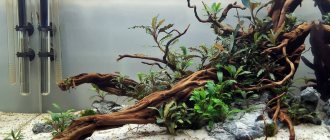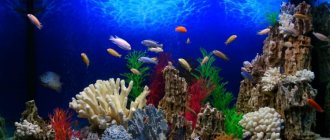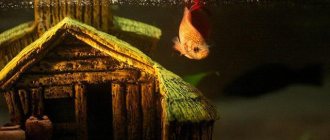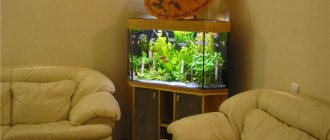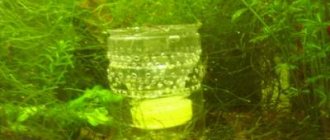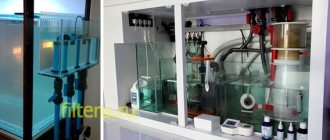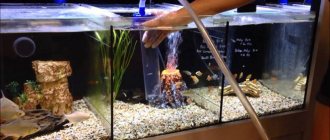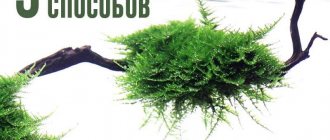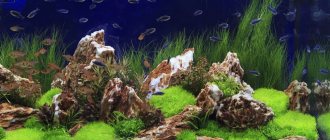Share this article:
In almost any aquarium, driftwood (part of a tree root) looks very beautiful. A intricately intertwined piece of mangrove tree installed in an artificial home pond gives the whole composition a natural feel. For a number of reasons, mangrove is becoming a very popular material for creating tropical waterscapes.
Description of the mangrove and features
The mangrove tree is unique. It grows on the tropical coasts of oceans and seas, and can also be found on the banks of tropical rivers. Mangrove trees grow in groups, closely intertwining their branches, sometimes creating impenetrable thickets.
Mangroves are represented in nature by three species (although, as it turns out, nature has created more than 50 species), which are truly unique:
- Black - grows directly in water. Through the root system, the plant receives oxygen and nitrogen, the nutrients necessary for its life. Pneumators emerge from the roots - shoots that in an adult tree can reach a length of more than 3 meters.
- The white appearance of the tree is no less unique and interesting. Its leaves have glands with the help of which salt is “pulled” from sea water. Salt crystals settle on the greenery of the tree. Thus, mangroves filter water for themselves, producing fresh liquid.
- Red variety - in the places where it grows, this tree is called walking. The red mangrove's root system sits above the surface of the water and prevents salt from getting into the tree. The mangrove bark is dotted with multiple pores, through which the plant breathes.
The branches of the mangrove are so intricately woven together that they visually look like a powerful, tightly drawn knot. Mangrove roots are nothing more than the highest quality natural filter, capable of releasing salt crystals from sea water so that the plant receives the fresh water it needs.
In nature, places in rivers where mangrove trees grow are the favorite habitat of many fish. Not only do they hide and spawn there, but they also have access to perfectly clean, filtered, fresh water. If a fry or a miniature fish hides between the close interweaving of mangrove branches, no predator will be able to reach it.
The life cycle of a tree depends on weather conditions and how often storms occur in the place where it grows, which mangroves, despite their power and strength, cannot always withstand. Over time, trees begin to die, they are torn out of the ground by high and strong waves during sea storms. And fragments of roots and branches end up washed ashore.
This is how a tree, obeying the laws of nature, is part of a windfall. These driftwood are collected and sold in pet stores so that every aquarist can buy them and create a miniature tropical underwater world in their aquarium.
What types of fish require snags?
Of course, it will be more fun for any fish, and it will be more interesting for the owner to watch their pets if the driftwood becomes part of the interior of the aquarium. But there are certain types of fish that simply need snags.
Thus, various types of catfish use the plaque formed on the surface of driftwood as additional food, and the thinnest upper layers of wood as a source of dietary fiber. These are fish such as panak, Orinoco catfish, ancistrus catfish, and cuckoo catfish.
Many fish, which in natural conditions prefer to spawn in the roots of trees that have fallen into the water, or old snags, are happy to do the same in an artificial environment. This is a large group of fish of the perch family (gourami, glass perch).
Long and narrow fish of the order moray eels and eels will also be grateful to you for a labyrinth of roots or small spreading snags and for reliable shelter.
You should be especially careful when choosing the size of snags if you keep very active or aggressive fish (some types of cichlids, for example), since such pets prefer rocky, stone reservoirs and can harm themselves by injuring themselves during vigorous movement and fights on protruding edges.
But here it is enough to follow a simple rule: there should be few snags, they should not occupy a large space and have sharp protrusions. It is better if it is one large, uncomplicated and smooth piece of a large branch, without shoots.
Mangrove tree in an aquarium
Beginner aquarists or just hobbyists do not immediately understand and know about the purpose of the mangrove tree, using driftwood from fruit trees growing in their region as decoration for their aquariums. Unlike mangroves, such driftwood will serve only one function - decorative.
At the same time, mangroves, in addition to their incredible beauty and the ability to ennoble even the most modest artificial pond with just one branch, perform many other functions that are useful and necessary for aquarium inhabitants:
- The close interweaving of branches serves as an ideal shelter for small fish and other aquarium inhabitants, whose lives large predatory neighbors are not averse to hunting.
- Unlike simple driftwood, for which fruit and ordinary trees are taken, mangroves filter water through themselves. In addition, such driftwood releases tannins into the water, albeit in small quantities, which increase the acidity of the water. But do not be afraid of this, a slight increase in acidity will not only not harm the fish, but will even be very useful for many aquarium inhabitants.
One of the most common problems that aquarists encounter when placing a tree branch in an aquarium is that it begins to float. But this will not happen with a mangrove snag, so there is no need to come up with any devices to secure it to the bottom.
Aquarium inhabitants such as sucker catfish will be delighted with a mangrove tree in an artificial tank. For them, the mangrove snag will serve as a source of a substance useful for catfish - cellulose, which, when it enters the digestive tract of fish, promotes better and active absorption of food. Some time will pass, and the sucker catfish will polish the surface of the wood to a shine.
Unlike other types of wood that are used in an aquarium, mangroves will not rot, they do not need to be replaced periodically, and will retain their original appearance and all useful functions for many years.
Snag from the pet store?
You can always buy decorative driftwood at your nearest pet store. Almost all such accessories are made from mopani (ironwood) or mangrove (mangrove wood). The choice is small, and such decor is very expensive.
Let's not rush to empty our financial reserves, but let's turn on our creative abilities and creativity. And we’ll make a beautiful aquarium accessory ourselves.
In developed countries, specialized championships and competitions dedicated to aquarium design are held annually. The directions in which underwater driftwood is used are called "ryuboku" (Japanese for "tree").
How to prepare mangroves for an aquarium
Installing a mangrove driftwood on the bottom of the aquarium does not require any additional equipment, since it just needs to be placed in the water. However, before putting the driftwood into the aquarium, it should be properly prepared and pre-treated.
After purchasing, the snag needs to be cleaned, removing the dirt and dust that has accumulated on it. This is easy to do - just rinse the driftwood under warm running water. If the root is dry, it needs to be softened using one of the following methods:
- Place the driftwood in any suitable container with water for a day.
- Place the root in a saucepan (only an enameled one is suitable), add hot (but not boiling water) water, add enough salt to form a solution of strong concentration (almost like brine). Place the container with the driftwood on the fire, bring to a boil and boil for 60 minutes. Then wash the driftwood under water.
In addition, there is another method that is often practiced by experienced aquarists. It is considered quite original and unusual, but it gives an excellent result - the driftwood is placed in the toilet cistern for a period of 3 to 5 days. What is the advantage of this extraordinary method? In addition to the fact that the driftwood is in water, which means it will swell enough and become saturated with water, during these days it will also be perfectly cleaned of impurities accumulated under the bark.
This method, such as boiling driftwood, is rarely used by aquarists, since it is quite difficult and time-consuming. But experienced aquarists prefer this method of preparing driftwood, because boiling in salt water destroys all pathogenic bacteria.
Where to find
You can always buy ready-made driftwood for an aquarium - now there are a lot of them on sale, very different, although some require additional processing.
Or you can make your own driftwood for the aquarium, your own, unique, and it’s not at all difficult. I have already prepared driftwood for my aquariums, and quite successfully, without any consequences.
First of all, you need to find a suitable tree, preferably of an unusual shape, but even from ordinary straight branches you can create a beautiful composition.
Tree roots are excellent for this purpose - they can turn out to be very bizarre in shape and no worse than mangrove snags. Some people advise taking ready-made driftwood from the nearest body of water, but our natural water reservoirs do not inspire confidence in me; such driftwood can poison the inhabitants of the aquarium. That's why I always use dry wood for this.
The main requirements for a tree are that it must be deciduous; it is not recommended to use coniferous wood for an aquarium. However, on one very popular forum there was a topic about starting an aquarium with driftwood from the roots of coniferous trees, and for the author of the topic everything went without consequences (APD had already used the roots of coniferous trees in her aquarium, very successfully and without digestion).
Suitable wood:
- willow;
- vine;
- willow;
- poplar;
- aspen;
- fruit trees;
- oak, but oak ones need to be cooked 2 times longer.
Ready driftwood
Nowadays it’s even easier to purchase ready-made driftwood. You can find them at the pet market, in specialized stores, in online stores, on AliExpress, etc.
Most often you can find two types:
- mopani;
- azalea root;
Both have their pros and cons.
Mopani. You can use it immediately by placing it in an aquarium - the driftwood will drown. However, there is a big drawback: it greatly stains the water. In some cases, this will be a plus if the aquarium contains fish that prefer dark water, such as neons, some tetras, and corydoras.
Azalea root. These are very decorative driftwood, used for the ryoboku style. You can pick up several of them, creating fancy shapes. The azalea root does not stain the water, but it does not sink either. Such driftwood must first be soaked in water with a weight attached so that it sinks. You can immediately place it in the aquarium, but you will have to work hard to secure it. There is no need to boil it.
How to care for driftwood
Situations often arise when mangrove roots have been properly prepared, but they still float up when immersed in the aquarium. This situation can be corrected by pressing the snag with soil or stone for several days. In just a couple of days the tree will be saturated with water, become heavier and stop floating.
At first, the snag may produce substances that cause the water to become colored, acquiring a slightly greenish-brown tint. There is no need to be afraid of this and rush to replace the fluid. For underwater inhabitants, such water does not cause harm; its color will gradually return to normal with periodic replacement.
Aquarists often encounter the phenomenon of the appearance of a white coating on driftwood, similar in consistency to fluff. This situation is not dangerous; the plaque does not pose a threat to the fish.
To prevent plaque on the roots in the aquarium, a filter or siphon must be installed.
In addition, changing the water will help remove plaque, but not the entire volume at once, but little by little. If mold appears constantly, it is recommended to keep catfish of species such as plecostomus or ancistrus. They will eat mold with great pleasure, which is completely harmless for them, as for other fish.
Preliminary preparation
Wood should not be moldy, rotten or rotten. You can identify rotten wood by pressing on it with your thumbnail - if a dent remains, you cannot use it. Preference should be given to a dead tree that does not contain vital juices, although freshly cut branches can also be taken, they will require pre-treatment.
The prepared driftwood must be cleaned of bark and dirt as much as possible. If the tree is not “dead,” it needs to be dried in the oven for a couple of hours, and thick driftwood needs to be calcined longer. Be sure to control this process so as not to start a fire. By the way, it is very difficult to remove the bark from fresh wood; this can only be done after drying.
Recommendations for keeping mangrove driftwood in an aquarium
When purchasing mangrove driftwood for an aquarium, you need to carefully inspect it before purchasing. Unscrupulous sellers may pass off branches or roots of the iron tree (mopani) as mangroves. The color of driftwood is approximately the same, but in mangroves it is brown evenly throughout the wood.
In addition, the appearance of the mangrove rhizome, which is a complex interweaving of many branches, is also different. Ironwood does not have such interlacing. You can check whether mangroves are real or ironwood by lowering a piece of driftwood into the water: mangroves will sink, other types of wood will float on the surface of the water.
The likelihood that the purchased mangrove snag will be rotten is extremely small, but this also happens sometimes. To avoid this problem, you should not buy driftwood in a sealed package without looking at it first.
Particular attention must be paid to the places where cuts and cuts are made. If a tree is rotten, it will be immediately obvious, and accordingly, such a tree cannot be purchased.
In order for mangrove driftwood to retain its original appearance for a long time and not lose its beneficial properties, it cannot be pulled out of an artificial reservoir for a long time, much less washed.
Tips and tricks
If you decide to purchase mangrove driftwood in a store or from hand, then first carefully inspect it. Sometimes, under the guise of a mangrove, part of the root or branch of mopani, the African “iron tree,” can be sold. The color of the driftwood is identical to the color of the mangrove, but the root shoots of the mopani do not have complex weaves.
You can check it in a simple way: even when dry, a piece of “iron wood” almost immediately sinks in water, sinking to the bottom of the container.
Rotting wood is extremely rare, but a similar situation is possible. If the driftwood is packaged, you should ask the seller to take it out of the packaging and examine it carefully, especially in the cut areas.
Parts of a mangrove tree (roots or a section of a trunk) are an excellent natural decorative material that does not require special preparation and helps to create a natural landscape in the aquarium.
